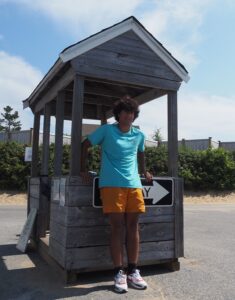EASTHAM — The closure of Cooks Brook Beach on the Cape Cod Bay side of Eastham from July 8 to 21 seems to have been caused by natural bacterial flourishing — rather than the usual culprit, contamination from human and pet waste.

In Massachusetts, as in most states, public health officials measure the safety of water at public beaches by testing for enterococci bacteria. Beach water must fall below the single-sample standard, which is no more than 104 colonies per 100ml, and the geometric mean standard, which is no more than 35 colonies per 100ml across the past five samples.
A single test over 35 colonies would not close a beach on its own. But at Cooks Brook, the sample collected by Barnstable County monitors failed on July 6, passed on July 7, and then failed on all five weekdays from July 10 to 14.
Eastham Health Agent Hillary Greenberg-Lemos wrote to town staff during that period that the previous five samples had been “all over the place,” ranging from under the single-test limit of 104 colonies all the way up to 2,000 colonies.
The next week, all five samples passed. By Friday, the geometric mean of the test results had fallen back under 35, and the town could reopen the beach.
“It was an interesting situation where there were several high consecutive samples, but it seems to have passed,” said Jennifer McMullin, the Barnstable County beach program coordinator, on Friday morning.
There have been several bacterial exceedances around Cape Cod this summer, which officials mostly attribute to stormwater runoff. “They’re usually pretty well correlated with heavy rain,” McMullin said.
But McMullin said she couldn’t be sure what caused the high counts at Cooks Brook. “It seems to me like it needed to have several days of tides to clean out whatever had accumulated along the coast there,” she said.
Town officials believe the exceedance was caused by a rich layer of peat in the Cooks Brook intertidal area that makes an inviting home for enterococci to reproduce. Beach subsidence or erosion has exposed the peat.
“The peat and those trees are normally covered with sand,” Greenberg-Lemos said. “Those little tree stumps that you see coming up everywhere, it’s kind of cool to look at. But that’s not normally what you see when you’re out there.”
According to longtime town and county employees, this has happened before. “Several people were around that remembered this problem in the ’80s,” Greenberg-Lemos said.
George Heufelder, who worked for the Barnstable County Dept. of Health and Environment for 40 years, including as director until 2017, said he had seen this happen at Cooks Brook about 15 years ago. When environmental factors align, natural bacteria incubators can pop up throughout the Cape, he said.

The peat beds act like a sponge, absorbing enterococcus and giving it an environment to potentially reproduce, Heufelder said. “I would wade out there when peat is immersed, take some samples right in the peat itself, squeeze it out, and see whether the counts were extraordinarily high,” he said.
If the results came back high, “I’d have to conclude that I just squeezed a sponge for bacteria,” he added.
Heufelder said he worked on the sanitary survey for Cooks Brook Beach 15 years ago and found “no obvious direct inputs from septic systems.”
The state has denied the town’s request for alternate testing to rule out wastewater at Cooks Brook, according to Greenberg-Lemos. “We’re going to continue to gather data and observe it and see what happens,” she said.
While enterococci are generally thought of as intestine dwellers, a burgeoning scholarly literature has demonstrated that these anaerobic organisms can proliferate in “extra-intestinal” natural environments, though they likely originate from animal feces. A 2014 Advances in Applied Microbiology article by Christopher Staley et al. summarizes findings that enterococci can survive in soil, sediment, fresh water, marine water, beach sand, and both terrestrial and aquatic vegetation if the conditions are right.
If this exposed layer of soft organic material is indeed acting as a natural bacterial sponge, Heufelder said, there’s nothing the town can do. But if surveys bear out this hypothesis, the real question is what a conservative public health approach to future bacterial exceedances would look like.
“There’s a quest for the ultimate indicator” that would flag only human waste, “but even with that, is the risk zero when the counts are high and you know it’s not human? No, the risk is never zero,” Heufelder said. “Everybody has to deal with how they respond to risk.”
The actual loss of elevation at Cooks Brook Beach that exposed the peat layer is not itself a major concern. The beach will rise again in the winter, Greenberg-Lemos said.
On the Saturday after the beach was opened, Eastham residents took full advantage of the scenic dunes and sparkling waters — peat or no peat.
Matthew Davis, 15, of Eastham was working the attendant’s booth. He said a lot of people had asked about the closure as they drove into the lot. Next to him was a stack of flyers, with a note to contact the health dept. with any questions.



